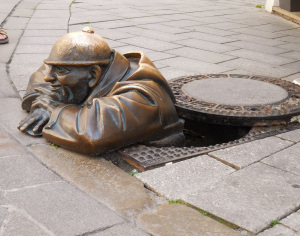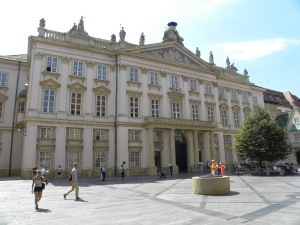Tanushree Podder's Blog, page 3
March 18, 2016
Solo in Singapore
My latest book is for readers with an adventurous soul..
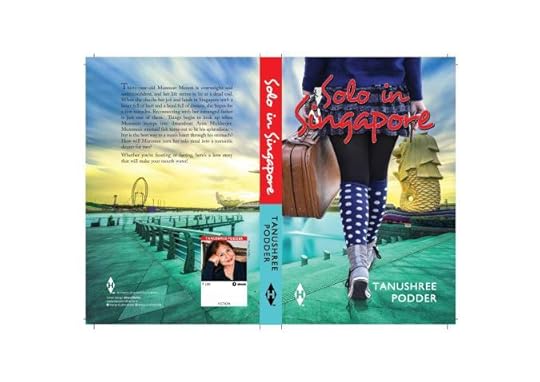
Breezy, funny and adventurous, Solo in Singapore, is about a thirty something girl called Munmun Menon. An overweight and under-confident girl, she buys a ticket to Singapore to run away from her troubles and thus begins her journey in an unfamiliar country..
Now available in all book stores as well as online ones –
Happy reading!
Filed under: Books, Travel Tagged: adventure, Book, country, fun, India, journey, Menon, Munmun, overweight, readers, Singapore, single girl








March 14, 2016
Martial art par excellence
For all those who have been raving about the Japanese martial arts and the feats of Jackie Chan, we have our own brand of martial arts and a very ancient one, too.
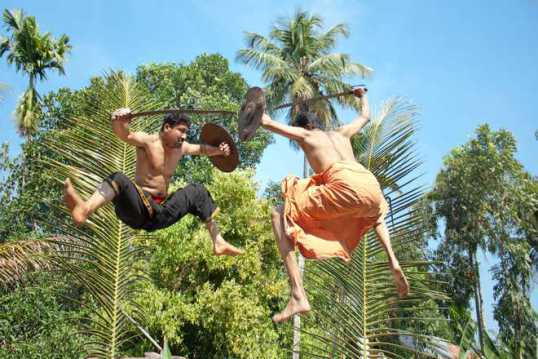
Kalaripayattu, which originated some 3000 years ago, has been mentioned in the ancient scriptures. According to some, the martial art form was first practiced by sage Parshuram, who is believed to have imparted training to a few disciples in order to protect the lands, which he had carved out of the ocean. Over time, this stretch of lands has come to be known as Kerala. Some of the scholars have traced it back to sage Agastya. Often called the ‘mother of all marital arts’, Kalaripayattu has survived for centuries.
There are many tales about the origin of the practice. Some stories subscribe the origin of other martial art forms to Kalaripayattu. Legend has it that a Buddhist monk carried the art form to China, which led to the birth of other martial art forms.Whether it originated in the times of Parshuram or later, the fact is that it is one of the most effective forms of self-defence. The word Kalaripayattu is derived from two Malayalam words — Kalari meaning an arena and payattu meaning combat. One of the oldest and most scientific forms of combat, it is closely linked to yogic exercises and ayurvedic practices.In the past, Nairs, the warrior community of Kerala, were the main practitioners of Kalaripayattu. It is said the martial art had also been used against the European invaders. However, the British banned the practice of the martial arts in the early 19th century after an uprising in the south of Kerala.
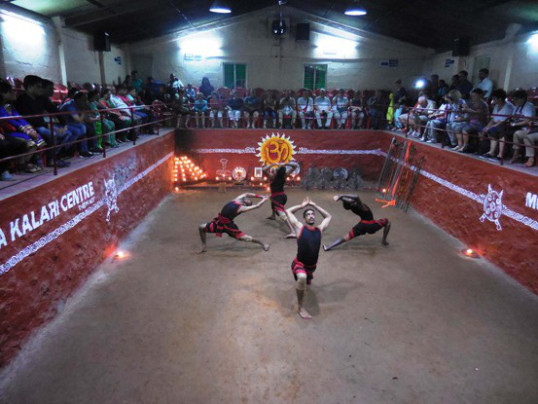
Practicing Kalaripayattu was punished by deportation but a few dedicated practitioners continued to practice the art in secrecy. They also trained dedicated young men so that the ancient art form would survive the test of time.Interestingly, every facet of this martial art form is based on rules laid out in the scriptures. The Kalari (arena) is designed on the tenets of vaastu shastra. Dug out at a depth of four feet, it has an east-facing entry and has specific dimensions. The floor is made of mud and in the west a seven-tiered platform, which denote the seven dhatus in the body, is constructed. Lighted lamps are placed on the steps while a lotus-shaped kumbha, representing the deity, adorns the top.
Weapons like sword, shield, knives, sticks, spears, etc. are placed on the western side.Training is rigorous with specified physical exercises, massage and meditation. The guru-shishya parampara is strictly followed and the guru is highly revered. Not just a supple body but alertness and swift reactions are mandatory for the students. Rules are strictly followed and deviance is forbidden. The martial art is a test of the body and mind as well as nerves of the combatant.
Today, most visitors to Kerala are treated to an hour-long, breathtaking demonstration of the combat skills of this martial art. Stunned silence reigns the Kalari as combatants leap, spar, grapple, wield sticks at 300 blows per minute, counter and evade opponent’s spear — thrusts, leap through blazing fire, somersault over 10 crouching volunteers and perform unbelievable stunts. No visit to God’s Own Country can be complete without a Kalaripayattu experience.Move over taekwondo, karate and kung fu, Kalaripayattu is raising its mighty head, once again.
(Published by Sunday Tribune, March 13, 2016)
Filed under: Travel Tagged: Agastya, ancient, ayurveda, British, China, kalari, Kalaripayattu, karate, Kerala, kung fu, malayalam, martial art, parashuram, payattu, taekwondo, vaastu shastra








In Vietnam’s defence
Cu Chi Tunnels, an underground village connected by a network of tunnels, became a haven for the Vietnamese during adversity..
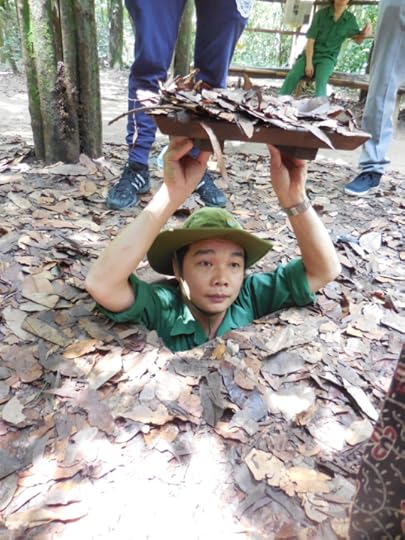
A fantastic camouflage technique at the mouth of the tunnel
A group of tourists followed their guide down a narrow entry that ended many feet under the ground, in a dark and deep hole. Soon, they were on their fours, crawling through a claustrophobic labyrinthine passage. They crowded the tunnel, lit up by the torch of the guide. The only sound that reached their ears was their laboured breathing. Slowly and painstakingly they crawled, wishing the journey would end. Suddenly there was a bright light at the end of the tunnel, and everyone gasped with relief.
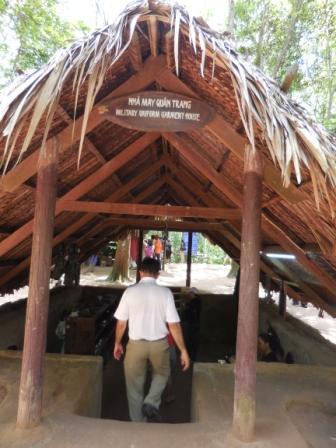
Descending the Cu Chi Tunnels, an underground network of tunnels, had been a horrifying experience for many Vietcong guerrillas and their families. They had stayed there for many years, living a life fraught with risk, deprivation and sickness, as they fought the foreign invaders on their land.
It was a proverbial David-and-Goliath war where the poor, ill-armed peasantry fought the superpower soldiers armed with sophisticated weaponry. Like David, the Vietnamese trounced the American Goliath, turning the American War (as Vietnamese call it) into the biggest US blunder. The statistics are staggering — 1.5 million dead, 3.50 million acres devastated, 8 million bombs used (more than double the number used in WWII.)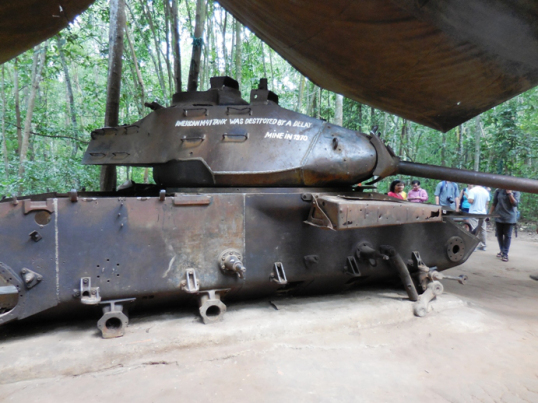
An American tank captured by the Vietcong
Around 18.5 million tonnes of Agent Orange sprayed over 31,00,000 hectares of farmland by the US Military ruined most of Vietnam’s fields. It maimed 4,00,000. It affected the future generations, resulting in about 5,00,000 babies with birth defects. Even today, a visitor to Vietnam is likely to come across visually and hearing-impaired children; and deformed children with cleft palate, mental disabilities, hernias, and extra fingers and toes.
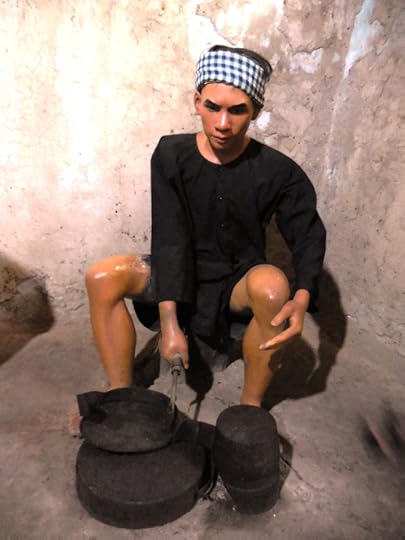
The model of a metal-forger inside the tunnel
The horrors of American War are visible in several museums across the country. The pictures and stories send shivers down the spine. Sadly, most of the information about war has come to the world only through the Western media. One can hardly find reports written by the other side. One is exposed to the truth only after a visit to the place. For a country that has fought foreign intruders for close to 1,000 years, Vietnam has been strangely reticent about its struggle. The Cu Chi Tunnels is but one witness to their struggle.
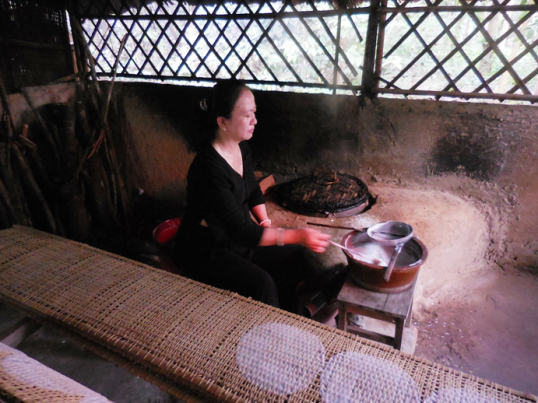
A woman demonstrates how to make paper thin spring roll wrappers.

The food they survived on
The digging of the tunnels began in 1948, during the French occupation. In the 1960s, digging was revived and continued for over 25 years. This time the tunnels were used to fight the US soldiers. It was tedious work, but it paid off in the end. The struggle to win back their freedom sent the locals deeper into the womb of earth so they could escape the bombing of an economically powerful enemy.
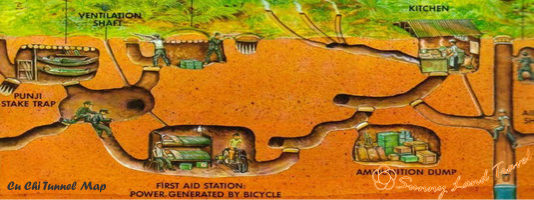
In an amazing feat, they managed to create a complex system of tunnels that stretched for 220 km. They laid it at various levels, ranging from 6 m to 10 m under the surface, and took it right up to the enemy territory, to the outskirts of Saigon. The tunnel could withstand aerial bombardments, including the lethally powerful B-52 bombs.
Running in a zigzag pattern with angled walls, the tunnels passed under villages and water sources. They were a masterpiece of design engineered to prevent detection. With well-camouflaged entry points & air shafts, booby traps, and an underground complex of hospital, kitchens, living & dining areas, storage facilities, weapon workshops and command posts, the Cu Chi Tunnels was an ingenious hideout for Vietcong. A series of booby traps to pin down the American soldiers made the tunnels impenetrable. The US army launched large-scale ground attacks, ravaged the fields, bulldozed the jungles, demolished the villages, but to no avail.
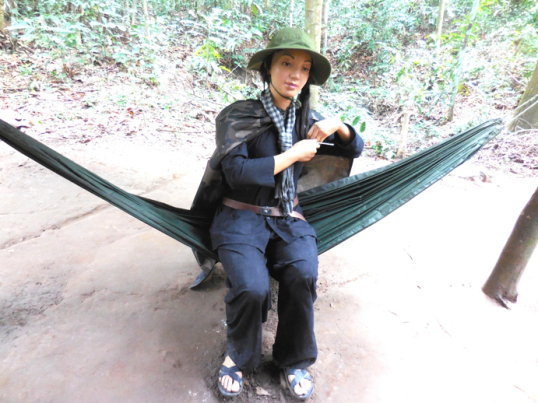
The model of a woman guerrilla resting after a day’s work
Against all odds
Frustrated, the US soldiers dropped Agent Orange and napalm bombs to raze the fields and villages that supplied rice to the fighters. When chemical warfare failed, the US army trained their soldiers as ‘tunnel rats’, who went down the tunnels and engaged in hand-to-hand battle with Vietcong. This had little impact, as did the use of German Shepherd dogs trained to locate the revolutionaries who began using American soaps and uniforms to mislead the dogs.
Life inside the tunnels was horrendous. Of the 16,000 Vietcong, only 6,000 remained to see the end of the war. Some statistics put that number at 45,000 Vietnamese men and women. Snakes, scorpions, vermin and diseases killed most of them. Malaria and scarcity of food and water were rampant.
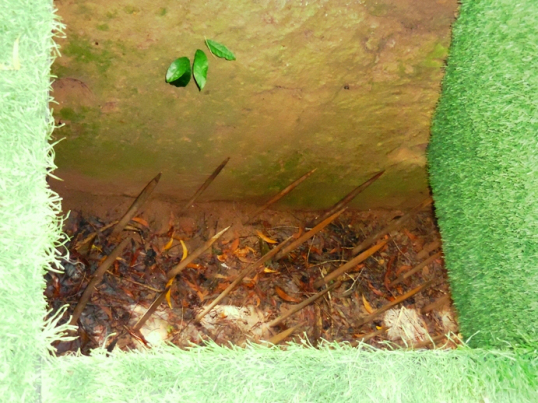
A booby trap for the enemy
In the final push, Americans carpet-bombed the area with B-52 bombs, which destroyed most of the tunnels, leaving death and destruction in its wake.

The picture of Kim Phuc, a 9 year old girl struck by napalm bomb
The one picture that changed the course of this war was that of a napalm-stricken naked girl, crying and running away from her napalm-strafed village. In the background were a few other children and some US soldiers. The iconic photo taken by a Vietnamese lensman provoked outrage and spelt out the horrors of the war more than any written word. The girl, Kim Phuc, was 9 years old, and the date was June 8, 1972.
Indomitable spirit
The Vietnamese, today, are determined to wipe the slate clean to move ahead. The attitude of forgiveness is best quoted by a survivor, Phan Thi Nhanh, who was a 14-year-old girl at the time of My Lai Massacre: “We don’t say we forget. We just try not to think about the past, but in our hearts we keep a place to think about that.”
A visit to the tunnels illustrates the determination of the Vietnamese and the extent to which they were willing to suffer in order to throw out the foreign powers. It’s impossible to come away without being affected by the spirit and willpower of the Cu Chi guerrillas. Today, the remnants of Cu Chi Tunnels serve as a tourist attraction. The Ben Duoc and Ben Dinh tunnel sites are located about 50 km from Ho Chi Minh City. The tunnels in these two areas have been renovated and widened to allow visitors.
Guides lead groups of tourists into the tunnels, some of which are so constricted that the hefty ones find themselves unable to squeeze through. The Ben Duoc area has a makeshift hall where a short film on the struggle is shown while the tourists wait for their turn to enter the tunnels. There is also a firing range, close to both the locations, where tourists can shoot at targets with M16 rifles or AK-47s.
(Published by Sunday Herald, March 13, 2016)
Filed under: Travel Tagged: Agent Orange, America, Atrocities, Ben Dinh, Ben Duoc, Cu Chi Tunnels, genocide, Guerilla, Vietcong, Vietnam, war








February 20, 2016
A bird watcher’s paradise
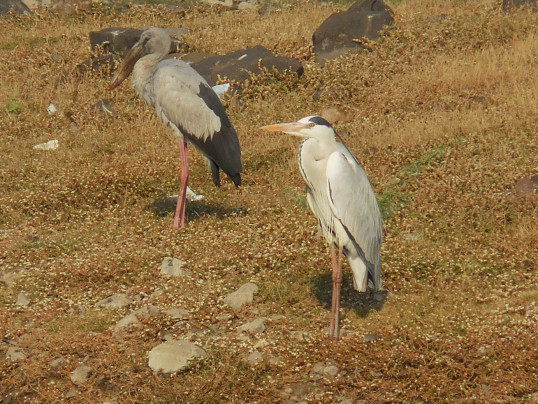
Asian Openbill
Less than a hundred kilometres from Pune lies a small and dusty village known as Kumbhargaon, which in the recent years, has turned into a bird watcher’s paradise. This has led to it being called the ‘Bharatpur of Maharashtra’ and ‘Mini Bharatpur’.
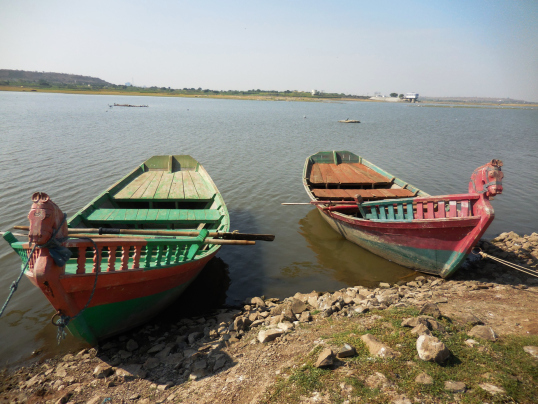
Each winter, the place turns into a hotbed of migratory birds, who flock here after migrating from the colder climes thousands of kilometres away.Kumbhargaon is a part of the small town, Bhigwan, located on the backwaters of Ujaini dam. This village sees more than 230 bird species but the most famous of the lot are the Greater Flamingos, which bring a riot of colours to the serene backdrop.
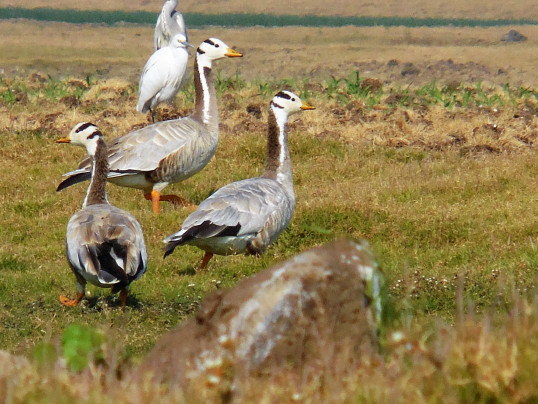
Bar headed geese
Painted storks, Brahminy duck, kingfisher, waders, egrets, herons, cormorants, Ibis, bar-headed geese, demoiselle cranes, spoonbills, you name it and the bird is there. Each year, a couple of new avian visitors have been spotted by keen ornithologists. Among them is the white-fronted goose, which generally doesn’t oblige bird-watchers with a sighting.
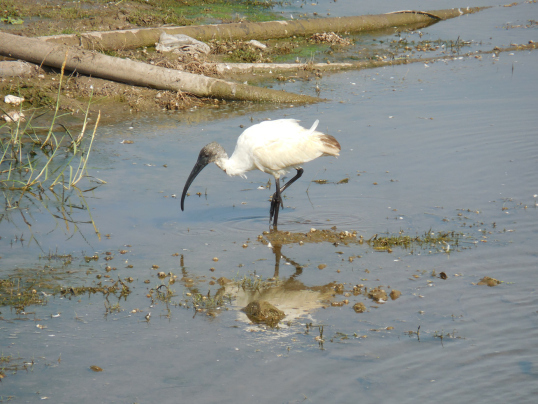
Blackheaded Ibis
The huge Yashwant Sagar reservoir, which forms the backwaters of the Ujaini dam, is known to host at least a thousand of the flamingo birds each year. These fascinating feathered creaturesmigrate from the extremely cold temperatures of Siberia to the western coast of India, to breed in warmer climes. Bhigwan sees a large number of the birds when there is an overflow at their usual haunts. The backwaters of the few wetlands in Maharashtra, thus becomes their habitat for a couple of months each winter.

Blackwinged Stilt
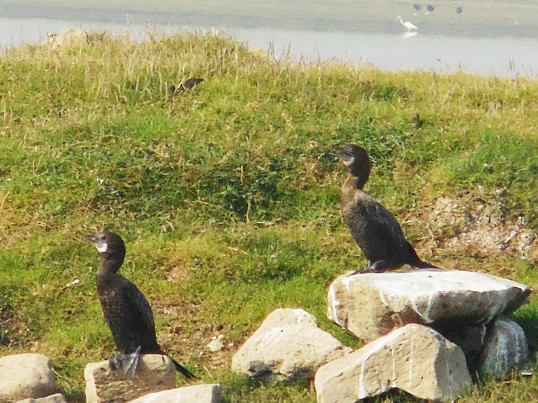
Cormorant
Armed with sophisticated cameras, enthusiastic bird watchers can be seen converging at the village during the peak birding season. Ecstatic exclamations emanate from each boatload of tourists, each morning, as they encounter flocks of avian friends. The fragile eco-system gets harmed when uncaring visitors leave behind plastic garbage, which find their way into the water. Not surprising, the number of flamingos have started dwindling.Bad monsoon is just one of the factors.

Egret and Cormorant
The growing number of fishermen, who have set up temporary shelters, is also a major reason that has added to the reduction in number of birds. Contractors have hired labourers to haul in large number of Tilapia, which is found in large numbers in the reservoir. These are then sold in the fish market at Bhigwan. The practice of unrestricted fishing by the contract labourers is adding to the woes of the migratory birds.

Grey Heron
Sandeep Nagare, an enterprising young man from Kumbhargaon, has set up an ecotourism initiative to encourage budding ornithologists.Hehas managed to create employment for the local boys of the village by training them about the birds. For a meagre fee of Rs. 100 per head, people can avail the boating as well as guide services of Sandeep and his team. Besides this, one can sample fresh Tilapia with homemade meal of fish fry, fish curry, rice, jowar bhakri and salad at an unbelievable price of Rs. 120. The sumptuous and nutritious fare, along with the draw of exotic birds, is enough to desire a repeat visit. Add to that the amazingsight of a flock of flamingos landing on ground and you will have experienced poetry in motion — an experience of lifetime.
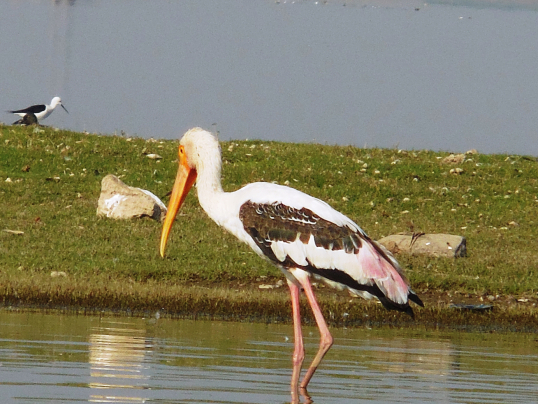
Painted Stork
Filed under: Travel








January 22, 2016
Nature’s work of art
If there was a dream sequence with a sparkling bay dotted with wind-sculpted knolls, weather-beaten and hollowed out into mysterious grottoes, fluttering sails of junk-boats and a brilliant sunset, it would have to be set in the Ha Long Bay.

Alternatively, imagine a thriller set among the rising hills with secret caverns and you would be right again. Your thoughts would match those of Guy Hamilton, the director of James Bond movie The Man with the Golden Gun, since he shot part of the film at Ha Long.
This magical landscape led to its entry into the list of World Heritage Sites. The words Ha Long mean ‘where the dragon descended into the sea’. According to local legend, Ha Long was created by a huge dragon to protect the local population from invasion.
There are about 2,000 tiny islands, which extend all the way from the Gulf of Tonkin. These islands are ringed by limestone hills and tiny strips of sand. According to some geologists the formations of limestone hills could date back to the Palaeozoic Era. The hills eroded by wind, tides and rain over millions of years created the interesting landscape that amazes tourists.

mere three-and-a-half-hour scenic drive away from Hanoi, Ha Long sees an influx of tourists during the high season. Ha Long is the bay’s main gateway, where the buses drop impatient tourists. Innumerable junk boats have been fashioned into a tourist-boat fleet to cater to the ever-growing demand. The road to the jetty is lined with many luxurious resorts and hotels. Ferried by the boats up to the well-furnished junk boats, tourists find themselves awed by the limestone monoliths soaring up from the emerald waters. Eagles lunge towards the unsuspecting fish. Seconds later they emerge victorious, the catch struggling vainly in their beaks.
Sleeping on the well-furnished junk boats is quite an experience. A two-day package comes with cooking and Tai Chi classes, sightseeing sprees and sumptuous meals. There are diving and kayaking opportunities, along with rock-climbing and fishing.
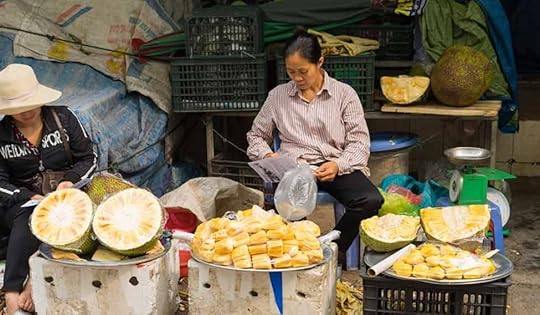 The view of the setting sun from the deck is magical and one can spend hours gazing at the scene unfolding before the eyes. The azure waters of the bay take a golden hue reflecting the streaks of a dying sun and the junk boats turn into shadows as the sun bids goodbye and sinks behind the hills. It is a humbling experience as one watches the magnificent unrolling of nature’s beauties in a serene setting that defies description.
The view of the setting sun from the deck is magical and one can spend hours gazing at the scene unfolding before the eyes. The azure waters of the bay take a golden hue reflecting the streaks of a dying sun and the junk boats turn into shadows as the sun bids goodbye and sinks behind the hills. It is a humbling experience as one watches the magnificent unrolling of nature’s beauties in a serene setting that defies description.
A post-dinner loll on a deck-recliner is equally unforgettable. A sky lit up with stars, the faraway twinkling lights of other junk boats and the silhouette of the hills have the makings of a brilliant painting. Tiny boats, laden with snacks, drinks and other offerings glide by, providing a photo opportunity to the shutterbugs.
The dawn is equally priceless as the sky gradually brightens and the mist rises exposing the shrouded hills. It wouldn’t be wrong to say that those moments make the trip worth the effort.

Those wishing to explore the many caves around the bay are rewarded by the stunning structures created by the stalactite and stalagmite formations over the centuries. The Sung Sot Cave, also known as the Surprise Cave, is the largest one in Ha Long Bay. After an arduous climb, visitors are rewarded by the spell-binding formations that have been created by nature. The platform outside the cavernous cave, provides a breathtaking view of the picturesque bay. For those who want to avoid the climb, there is the Dong Thien Cung, which is equally rewarding.
The tiny strip of beach is overcrowded with sunbathers and swimmers but watching the majestic mountains as waves crash against them is a sight to behold. Kayaking in the lagoons is quite popular with those who want to exercise their arms while those with sturdy legs often venture out to conquer the nearby hill summit. For others, who are looking forward to communing with nature and opt for a quieter experience, there is the deck on the boat.
The nearby Cat Ba Island has a national park that makes it worth a visit. There are adventure sports like trekking, rock-climbing and sailing. There is also the Bai Tu Long Bay, which is just a short boat trip away and promises a much private experience since not many tourists venture there. Although the scenery is not as stunning as at Ha Long, the number of junk boats in the area is much less and the bay offers the same opportunities of visiting the caves, kayaking and swimming.

Getting there
There are buses that run between Hanoi and Ha Long. Most travel agencies at Hanoi offer packages for Ha Long Bay. The hotels may also have dedicated travel desks that make the arrangements.
Booking a cheaper cruise may sometimes lead to an unhappy experience as there are several unscrupulous boat companies in the area. Some of the reputed cruise companies are Paradise Cruise, Halong Party Cruises and Au Co Cruises.
Stay
If you want to stay for a longer time at Ha Long city, you could look at the various options that are offered in various price segments. Novotel Ha Long, Royal Lotus Hotel, are situated within walking distance from the pier. Comfortable and affordable, they offer a beautiful option of staying with a striking distance from the bay.
The right time
The best time to visit Ha Long Bay is March to mid-June. The weather is foggy and visibility is low from January to March. Tropical typhoons that normally take place between mid-June and September can lead to cancellation of tours. So check before you make the bookings. It is sensible to book with tour companies that offer full or partial refunds in case of cancellation owing to bad weather. September to December is ideal for those looking for off-season prices.
(Published in The Week, December 13, 2015)
Filed under: Travel, Wine and Cuisine Tagged: Cat Ba Island, Dong Thien Cung, Gulf of Tonkin, Guy Hamilton, Ha Long, Ha Long Bay, Hanoi, James Bond movie, Sung Sot Cave, The Man with the Golden Gun, Vietnam








January 1, 2016
When in Greece, eat as the Greeks do
Mediterranean diet is counted among the healthiest diets on earth and Greeks are no exception. Hippocrates said to have said — let food be thy medicine and the Greeks follow his advice seriously.Greek cuisine is a blend of flavours that came from diverse influences for more than a thousand years, and they have managed to retain them.
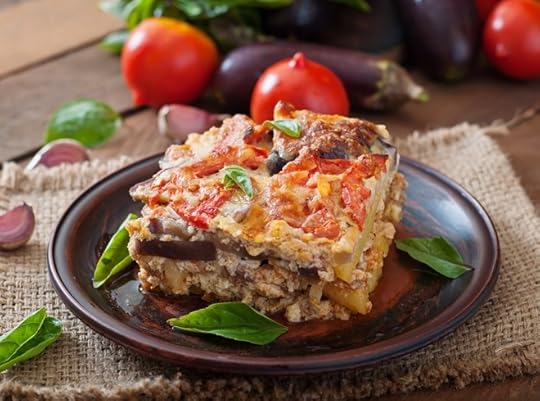
The food culture, there, began way back in 350BC when a Greek called Archestrolus penned the first cookery book.It is said Poseidon and Athena contested for the patronage of the Greek capital. Poseidon struck his trident into the ground, and a spring appeared but the water was salty. Athena, however, planted an olive branch, which grew into an olive tree and was chosen as the patron goddess of Athens.
Today Greece prides itself on the best olives and olive oil in the world. It is this ingredient that makes Greek cuisine healthy.Some of the dishes like dolmades have not changed over the centuries. The delectable dish made of vegetables, meat and rice stuffed grape leaves is still made the way it was made during the ancient times.What made the dishes healthier was the basic nature of them.
For instance, bread was eaten dipped in olive oil and the bread was made from barley, rye, millet or wheat. Bread, olives and wine were the basic food. All very healthy and nutritious. Most of the protein came from fresh fish with meat being used rarely. Besides, ancient Greeks used honey instead of sugar (which was unknown to them) to sweeten food. Later, figs and cheese made their way to the Greek tables.

Here’s a look at a few popular and traditional Greek dishes.
Horiatiki salata: The Greek Salad is a perennial favourite. What began as a peasant salad in ancient Greece with very few ingredients like tomato, olives, onion, cucumber and feta cheese, is now a much embellished version containing radish, anchovies and pickled peppers. Feta cheese is one of tastiest and lightest cheeses and is lower in fat content, which makes the salad a filling and healthy option.
Horta vrasta: The words mean boiled greens and it is just that. The dish is served in most Greek homes. Whether it is mustard green, amaranth, spinach, scallion or dandelion, boiled and dressed with a sprinkling of olive oil and lemon makes it a healthy dish.Moussaka: This is a familiar name for most foodies and a very popular dish, too. While traditionally it was made with eggplant and meat, recent innovations include a layer of potatoes, lettuce and zucchini topped with béchamel sauce. It is a complete meal by itself.
Souvalakia/Giros: This street food so popular with the tourists is not a traditional dish. It is clearly a Turkish influence which might have arrived with the Turk invaders. Served with the delicious tzatziki — a yogurt and cucumber sauce, the grilled meat is rolled in a pita with fresh vegetables and tzatziki, a cucumber-dill yogurt sauce. It is delicious, pocket friendly and filling
Arni kleftiko (klevo means stealing): This meat dish owes its invention to Greek rebels who were fighting against the Ottoman occupiers. Hiding in the mountains, they stole the ingredients, sealed them in clay pot and buried it in a pit with hot coals. simple and delicious, it is perhaps the healthiest way to cook meat.
Fried calamari and maridaki: Fish has played an important role in Greek cuisine and these two dishes are superlative in taste and popularity.
(Published in Sunday Tribune, November 8, 2015)
Filed under: Travel, Wine and Cuisine Tagged: Archestrolus, Arni kleftiko, Athena, Fried calamari, Giros, Greece, Greek Food, Hippocrates, Horiatiki salata, Horta vrasta, maridaki, Mediterranean, olive oil, olives, Poseidon, Souvalakia, tzatziki








A ticket to paradise on the hills
I am standing on the hallowed soil of a hill station that has hosted innumerable distinguished personalities through the decades. A person no less than Swami Vivekananda set his foot here before he undertook his famous journey to Chicago to speak about Hinduism before an audience drawn from all parts of the world. I am in a town with celebrity connection.
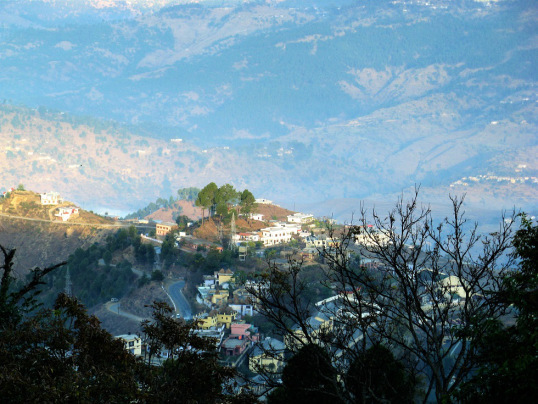
The renowned dancer Uday Shankar loved the place and set up his first dance school in the town in 1930s even as world war raged through the world. His nephew, the famous musician Anand Shankar, composed a piece he named Almora. Several prominent leaders like Jawaharlal Nehru, Khan Abdul Gaffar Khan, Acharya Narendra Dev were imprisoned in Almora’s jail during the freedom struggle. Sir Ronald Ross, who won the Noble Prize for medicine in 1902, was born at Almora to a British army officer. Rabindranath Tagore chose this town to recoup from the grief caused by the loss of his child.
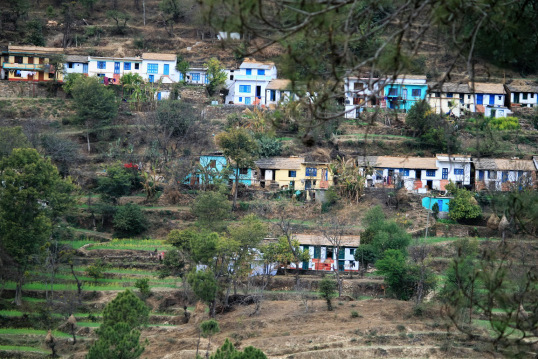
Bursting with beauty
As I set my foot in the town of Almora, a vibrant rainbow coloured the sky over the valley. It is an omen of good luck, I decide. The town is situated on a bare saddle-shaped ridge between dense forests of fir and pine trees, with a backdrop of the lofty snow-capped peaks of Himalayas. The serenity and beauty of the Kumaoni hill station lulls my city-worn senses like a shot of sedative. With the chilled winds blowing in from the Himalayas and the eyes soaked in green bliss, I stand spellbound with the beauty around me. The rolling green meadows with the meandering river down below and the pine forests rising up like smiling phantoms, it is a blissful holiday for city-weary people like me.
Sauntering idly, I chance upon the Tagore House where Rabindranath Tagore had stayed during his visit to Almora in 1937. It now houses government offices.
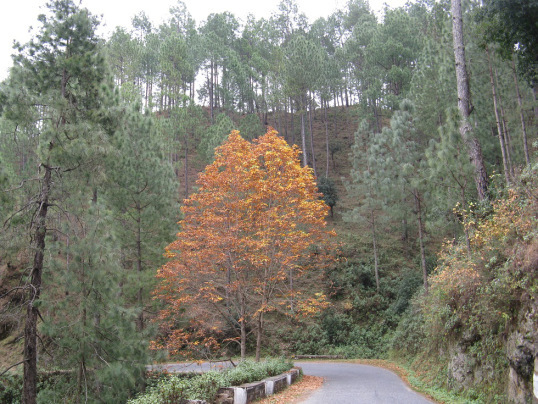
The next morning I wake up to catch the miracle at Bright End Corner, known for its views. My heart skips a beat as the first streak of sun hits the city, the sky lights up in an orange glow and the rays bounce off the snow-covered peaks and the clouds begin lifting in a slow motion. My eyes are treated to a symphony of colour and beauty. Sighing with pleasure I make my way to the nearby Ramakrishna Kutir. It is said that Swami Vivekananda made no less than three trips to Almora; once after the passing away of Sri Ramakrishna, again in 1897 when he gave a lecture on the platform right in the middle of the market place. The last time he came was in 1898.
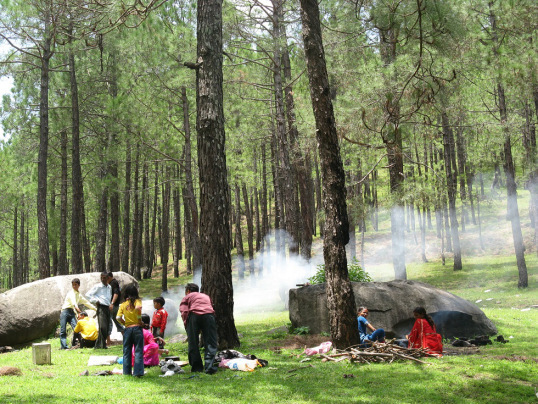
My walk takes me to the heart of the city where I do the ritualistic obeisance at the much-revered Nanda Devi and Narsingha temples. The Nanda Devi Temple was where freedom fighters congregated to hold important meetings during the freedom struggle. The Kumaoni Hills are filled with temples resplendent with hundreds of brass bells and petitions from the devotees. A very British construction greets the eye. It is the post office and the clock tower built much before Independence. An old gentleman narrated his experience of the announcement of Independence being made on the loudspeaker in this very square.
Secrets of the forest
It wouldn’t have been right to end the day without a trek in the forests, so I walk over the bed of pine leaves with no other sound than the crackling of dried leaves under my feet. The experience of silence during the trek through the pine and deodar forests is exhilarating. The magnificent deodar trees house so many colourful birds and squirrels that I continue to loll by them, training the binoculars on the chirping beings. Legend has it that these areas were guarded by tigers to protect people from harming the Deodar trees.
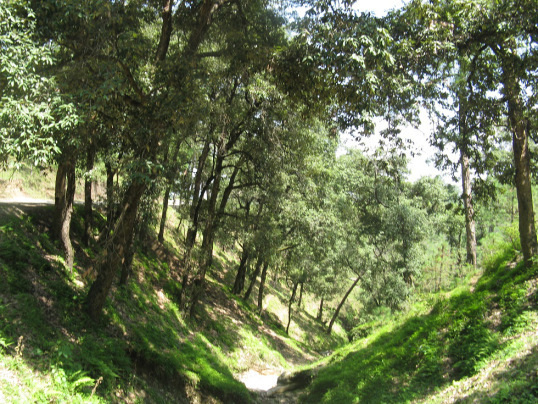
Kosi River beckons me from a distance, but the weary feet can walk no longer and I return to my haven in the town. This time I discover the ‘Kundan House’ where the agricultural scientist Bosi Sen and his wife, a renowned author, Gertrude Emerson, had lived for almost half a century.
Time is running out. My tryst with Almora is fast coming to an end, but the azure skies, mist-filled forests, the terraced fields interspersed by stone slated barrack-like village houses with their vivid blue windows and doors and the distant Himalayas remain etched in my mind.
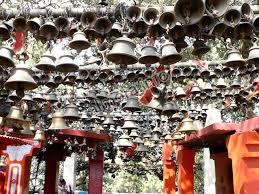
Fact file
Reaching There: The nearest airport is at Pantnagar (125 km) and the nearest railhead is Kathgodam (87 km).
Staying: There are umpteen staying options at Almora. Ramakrishna Kutir is serene and lovely. Deodar Resort, Snow View Resort, Hotel Himsagar and Kalmatia Sangam are some of the other options depending on the depth of your pockets. The cottages at Kalmatia Sangam are expensive but beautifully done up. Also check out the Kumaon Mandal Vikas Nigam’s Gollu Devta TRH on Mall Road. It has clean and affordable rooms.
Shopping: The best places for shopping are located in the old bazaar where you can empty your pockets on Almora’s copperware. The other buys to go for are the shawls and woollen jackets and if it is tweed you care for, it is also available. For those with a sweet tooth, a taste of ‘bal mithai’, the local sweet, is recommended.
(Published in Sunday Herald on December 13, 2015)
Filed under: Travel, Wine and Cuisine Tagged: Almora, Anand Shankar, Bal Mithai, Bright End Corner, Deodar trees, Hills, India, Kalmatia Sangam, Kosi River, Kumaon Hills, Kumaon Mandal Vikas Nigam, Nanda Devi, Rabindranath Tagore, Swami Vivekanand








City of the Ascending Dragon
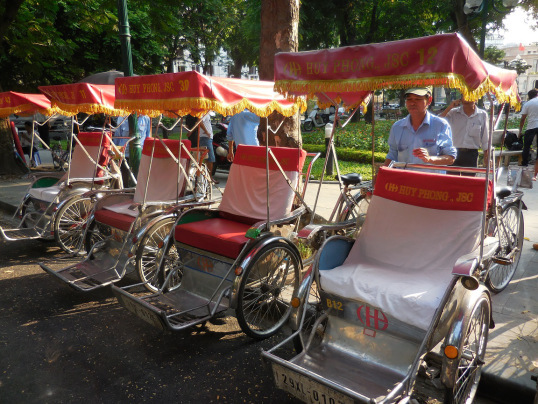
Vietnamese refer to it as the City of the Ascending Dragon. Long ago, sometime in the 11th century, King Ly Thai is fabled to have seen a golden dragon rising from the Hoan Kiem Lake. The vision moved the king so much that he shifted his capital to the lakeside.
A fortress was built and the court settled there. 36 streets came up in the neighbouring area to cater to the needs of the kingdom. The city was called Thang Long.The lake still remains as do the 36 Streets in the Old Quarter but the city’s name has changed to Hanoi.
Much has changed since then. Hanoi has shed its communist past and adopted a path of rapid progress. The ravages of the long wars it fought with the invaders are being slowly erased. Its citizens are eager to catch up on the lost time. Hanoi, the capital of Vietnam, is a busy and bustling city.

It is a quaint city with an Old Quarter, French Quarter and the outskirts. The Old Quarter, with its labyrinthine lanes, reflects the traditional lives of the locals. All one has to do is to walk its 36 Streets to get introduced to the quintessential Hanoi.The streets are a cornucopia of creative treasure. These are named according to the business carried out there.
There is Medicine Street, Silk Street, etc. each one with a prefix of Hang. For instance, Hang Cot is the Bamboo Street, where everything made with bamboo is available. Hang Non is for hats and Hang Dong for copper items.
Cycles, mopeds and scooters swarm like ants in the main road while the streets are full of wayside eateries, where people slurp bowls of the national dish known as Pho (beef-enriched rice noodle soup).The French Quarter is a contrast. With French architecture, colonial villas and tree flanked wide avenues, it is the area where the Indo-Chinese History Museum and Opera House stand. It is also where most luxury hotels, boutiques and shopping arcades are located. Hoan Kiem Lake is the centrepiece of the city.
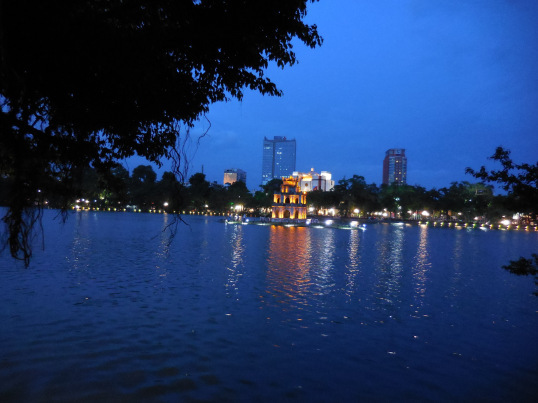
Serene, atmospheric and beautiful, this is where the locals congregate each morning and evening to catch up with a spot of Tai Chi or a view of the sunset. Tired shoppers, romantic couples, frolicking children and senior citizens occupy the stone benches around the lake every evening.With its past association with China, the Chinese influence over architecture, food and customs is very noticeable.
The exquisite pagodas are a big draw with the visitors.It is impossible to be at Hanoi and not say ‘Hello’ to Uncle Ho, as Ho Chi Minh is fondly known. Long queues at the mausoleum are an evidence of the popularity of the national hero, who is considered the father of Vietnamese nation.Inside the mausoleum lies the well-preserved body of Ho Chi Minh.
The modest stilt house where he lived is a tourist attraction.Right before the house lies a sprawling lake fringed with trees. It is said Uncle Ho came here every day to relax and rewind. He would clap and the fish would appear. Ho Chi Minh would then feed the fish. They would go back satisfied and he would return rejuvenated to his study to catch up the rest of his work.
Encouraged by the story, many tourists try to lure the fish by clapping. The fish don’t oblige, of course.The three-storey Presidential Palace, built in Indo-China style of architecture stands right across.

The mustard yellow structure was used by the visiting dignitaries although Uncle Ho stayed in the unpretentious stilt house. Interestingly the pathway from the palace to the stilt house is lined with mango trees and is known as the Mango Alley.

The One-Pillar Pagoda, Fine Arts Museum and Army Museum are within a stone’s throw away from the mausoleum. The Temple of Literature, which was founded in 1076 as the Imperial University and is listed as Vietnam’s first university.
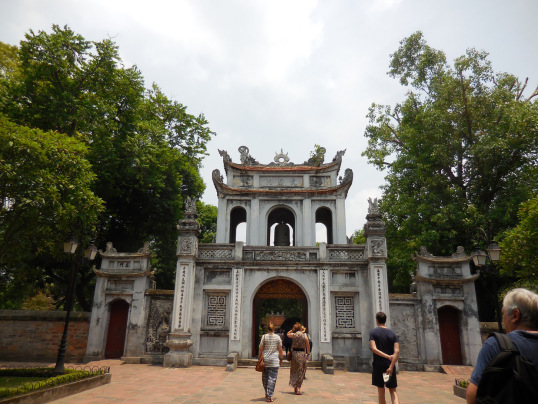
Exquisite pagodas, five lovely courtyards, temples, lake of literature and beautiful gardens make the place a restful treat for the senses.
There are giant stone turtles with stone slabs at the back. Inscribed on the slabs are the names of those who passed out with highest grades. These are considered a symbol of good fortune and it is customary for local students to touch them for luck, before the exams.Visiting the Hoa Lo prison is like travelling from serenity to horror. Known as Hanoi Hilton by the American airmen, it showcases the atrocities suffered by the Vietnamese during the French colonial regime. Exhibits include a metal guillotine that was responsible for many executions during that era.

The hall that displays the life of US captives, with its packs of card, cutlery, books and chessboard shows a sharp contrast between the lives of the Vietnamese and the American prisoners.As sun begins dipping, there is no better place than the Hoan Kiem Lake to watch it bid goodbye and rest the weary feet.
The best way to round off the day is by watching the famous water puppet show, an ancient Vietnamese art, which is performed at a theatre standing at one of the lake. The art of water puppetry originated in the 11th century and remains a popular entertainment to this day. Fire-breathing dragons, colourful fish, lively puppets tell stories from the traditional Vietnamese life to the accompaniment of the instrument known as Dan Bau.
A commentary in the background enlivens the show.Hanoi is not a place that can be covered in totality in a framework of a day or two. To do justice to the city would require at least a couple of weeks. The famous street food, arts and crafts, coffee culture and friendly people haunt the memories of visitors for a long time.

FACTFILE
How to reach: Many airlines like Vietnam Airways, Thai Airways, Singapore Airlines and Jet Airways fly from India to Hanoi
Where to stay: Vietnam is very affordable. However, the thumb rule is that the hotels in the Old Quarter are cheaper than those in the French Quarter. A five-star hotel like Hilton Hanoi Opera costs Rs 5,000 per night while a 2-3 star in the Old Quarter is just about Rs 800-1200 per night.
What to eat: Street food here is inexpensive. A cost of a bowl of Pho, which is rice noodle soup with beef, is a meal by itself and can cost as low as Rs 50, provided you are willing to sit on a plastic stool on the street-side and enjoy it with the locals. Sea food lovers will find the place a veritable paradise of offerings. Some of the must-haves are the famous Goi Cuon, bun cha, Cha Ca, Ca Mau, Com Tam and Vietnamese cold coffee.
What to shop: Silks, ceramics, black-and-red lacquer ware, woodcarvings and bamboo artefacts are some of the most popular shopping items. The local silk dress Ao Dai is a beauty. There are shops that can tailor it for you in 24 hours. Vietnamese coffee is famous globally as is green tea. Intricate paintings on silk are a local speciality. Bargaining is a must. Almost everyone haggles and to fantastic results.
Getting around: Cyclo (cycle rickshaw) is an easy way to cover the city. Beware, the cyclo drivers often ask for stupendous amount so bargain well and ensure the route. It is also possible to hire bicycles and pedal around the city.
(Published in Sunday Tribune, November 29, 2015)
Filed under: Travel, Wine and Cuisine Tagged: Cyclo, French Quarter, Hanoi, Hanoi Hilton, Ho Chi Minh, Hoa Lo, Hoan Kiem Lake, Old Quarter, One-Pillar Pagoda, Pho, Vietnam








October 24, 2015
Astounding Athens
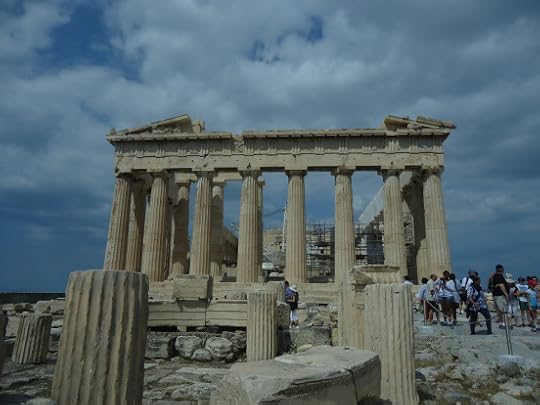 The Parthenon
The Parthenon
How does one begin to describe a city that has captivated the imagination of travellers for several centuries? Home to ancient temples like Parthenon and Acropolis, philosophy and democracy as well as hedonistic delights, Athens captured imagination for centuries.
Names like Socrates, Aristotle, Plato, Sappho, Pythagoras and Archimedes as well as mythological characters like Zeus, Athena and Apollo come to the mind as soon as the word Athens is mentioned. With its cobblestoned, labyrinthine lanes, imposing structures that echo with fables, it remains one of the most exciting destinations to this day. Needless to say that the city figures at the top of every traveller’s bucket list.
Armed with scores of suggestions from well-wishers, a copy of a travel guide and stars in my eyes, I alighted at the Athens International Airport intending to cover a lot of ground in the next one week.
In the heart of history
The same morning saw me take a train to the iconic Acropolis in the company of hundreds of tourists, each one eager to capture a slice of history in their camera. The Acropolis Hill, aka Sacred Rock, saw hectic activity in the 5th Century BC when architectural wonders began taking shape on it. Gasping for breath after a steep climb, I stood transfixed at the Propylaea, an imposing gateway that leads into the ancient citadel of Acropolis. Immediately on my right stood the tiny temple dedicated to Nike Athena that commemorates the Athenians’ victory over the Persians. It’s another matter that the temple was broken down by the Turk victors so they could place their cannon.
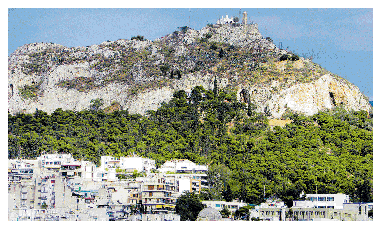
The Acropolis towers over the city
It is the Parthenon, the large Doric temple dedicated to Athena, the patron goddess of the city, that occupies centre stage on the rocky outcrop towering over the city. A beautiful frieze running on all four sides once adorned the temple. The story of the Elgin Marbles, a collection of several statues from the frieze, bought by Lord Elgin from the Turk invaders, and placed in the British Museum is narrated with resentment by the Greek guides.
The Erechtheion, a temple dedicated to Athena and Poseidon, sits where the two of them competed for the post of patron God of the city. Joining the gawking crowd, I stood before what was once the Porch of the Caryatids. A replica of them now stand in the original site while the originals have been placed at the Acropolis Museum.
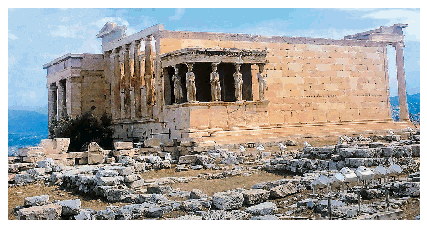 The Porch of the Caryatids
The Porch of the Caryatids
On the lower level of the Acropolis sprawls the Odeon of Herodes Atticus, a 161 AD theatre, that can seat 5,000. The huge crescent shaped theatre is now a venue for concerts and ballets and has seen performances of famous artistes like Maria Callas, Frank Sinatra, Pavarotti, Elton John and Yanni.
 Odeon of Herodes Atticus
Odeon of Herodes Atticus
A little distance away lies the ancient Theatre of Dionysious, which could accommodate more than 15,000 spectators, once upon a time. During its heydays the theatre has seen the works of Greek playwrights like Aeschylus, Sophocles and Euripides being performed. It then became a venue for gladiator combats during the Roman times. Today, Jethro Tull fans in Greece rave over the fact that he performed the first ever rock concert in the same hallowed theatre.
From the northeast corner of the Acropolis a stunning view awaits visitors. Right from the ceramic tiled roofs of the Plaka neighbourhood to the Hadrian’s Arch and the Olympic stadium, the city fans out under their feet.
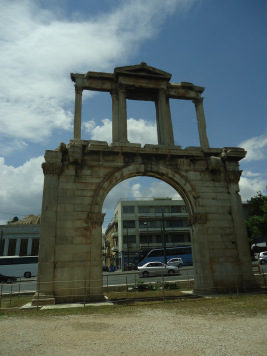 Hadrian’s Arch
Hadrian’s ArchCultural escape
It was close to dusk when I walked down the hill towards the Plaka area with its white-washed houses and narrow lanes dotted with traditional pubs. Built on the steep slopes of the Acropolis, the village is a favourite tourist haunt looking for atmospheric cafés and restaurants, or for buying souvenirs. Seated in a tree-shaded open air restaurant, I feasted on delicious moussaka while watching the people pass by.
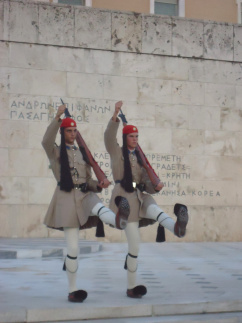 Change of guards
Change of guardsThe next morning, I walked toward the Syntagma Square in front of the Parliament. Known as the heart of Athens, it leads to the museum mile, where most of the important museums like the Benaki Museum, Museum of Cycladic Art and the Byzantine Museum are located. The other end of the square leads to the Ermou Street, which is the famous shopping district of the city. The changing of the guards at the Parliament brings hordes of excited tourists who wanted to pose for photographs with the evzones in their traditional uniform of kilt, red clogs adorned with pompoms.
Someone told me that if I had the time to visit just one museum, it should be the National Archaeological Museum of Athens. Remembering the advise, my feet turned towards it and not for a moment did I regret spending close to half a day there.
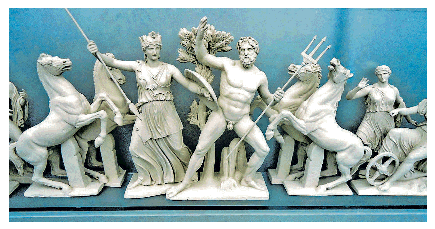
A beautiful frieze in the Acropolis Museum
It would have been blasphemous to miss the famous Acropolis Museum, I had been told by another well-wisher. The state-of-the-art Bernard Tschumi building with an exhibition area of 90,000 square feet on three levels, the museum is a repository of Greek culture and history. An archaeological excavation of the site revealed ruins from the 4th through 7th centuries AD. These can be seen through the glass covering that protect them. One of the most popular exhibits is the collection of four maidens from Erechtheion. The huge windows that overlook the Acropolis lend the most beautiful visual to the entire experience.
Another museum that should be on the list of every visitor to the city is the Benaki Museum, which holds a vast collection of Byzantine and Islamic objects.
It was unimaginable leaving Athens without visiting the Ancient Agora. The agoras of ancient Greece were public places where people could gather to discuss politics and hear public declarations. This was where Athenians gathered, in the 5th century BC, to hear Socrates’ speeches. Agoras also served as open air markets where artisans and traders set up shops to sell their wares. Slave trading also took place in these markets.
It was my last evening at Athens and I decided to spend it on Mount Lycabettus, which is the highest peak in Athens and offers a spectacular view of the city as well as Piraeus, the largest port in Greece. A 10-minute ride on the funicular from Kolonaki took me to a memorable experience of the day. Later, dining in the café on the hill, I mused about the city that offers so much and demands repeated visits.
Fact file
Getting there: Many airlines like Lufthansa, Qatar, Etihad, Jet Airways and Emirates fly between India and Athens.
Best time to visit: Between June and September
Where to stay: There are many high, medium and low end hotels in the Plaka as well as the Syntagma area.
What to drink: Ancient Greeks worshipped wine and the wine god Dionysus, so savour the ‘retsina’ and don’t come back without sampling the ‘ouzo’, the aniseed flavoured liqueur, which is considered as the national drink.
Getting around: Getting around the city is best done with a day’s pass which can be used in metro, bus as well as tram.
What to eat: Greek salad with its delicious feta cheese is a must-sample, so are souvlaki, moussaka and lamb kleftiko.
Shopping: The Ermou and Kolonaki areas offer high street fashion while Plaka is the place for souvenirs. Don’t forget to visit the Monastiraki Flea Market if you are looking for great bargains.
(Published in Sunday Herald on 25 October, 2015)
Filed under: Travel, Wine and Cuisine Tagged: Acropolis, Acropolis Museum, Aeschylus, Athens, Benaki Museum, Byzantine Museum, Erechtheion, Greece, Hadrian’s Arch, Jethro Tull, moussaka, Museum of Cycladic Art, Odeon of Herodes Atticus, Olympic stadium, Parthenon, Pavarotti, Plaka, Poseidon, Sophocles, Syntagma Square, Theatre of Dionysious, Yanni








Gem on the Danube
Napolean’s soldier leans on a bench in the busy square, smiling sardonically at the passersby. If people are surprised by the sight of him, it is because many are unaware that Napoleon’s soldiers were seen twice in the city, first in December 1805, after the battle of Austerlitz, and then again when Napoleon entered the city.
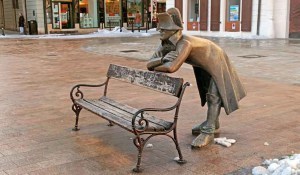 Napolean’s soldier stands on the square
Napolean’s soldier stands on the squareA sewer worker named Cumil peeps out of a manhole and a cheerfully-waving man with a top hat draws the indulgent smiles of visitors. The waving man is Schöne Náci, who wandered the city streets dressed elegantly, doffing his hat at the women who walked past. A paparazzi aims his camera at the pedestrian from the corner of a street. They are all among the many interesting statues that dot the city.
Cumil stares at the passersby
In a light mood, I join a horde of tourists walking down the Old Town, who had descended for a day trip from Vienna. That’s the way it is with most tourists who visit the tiny capital. It really doesn’t matter since most of Bratislava’s sights are within a radius of a couple of kilometres. Unlike other European cities, sightseeing in this city doesn’t require too much planning or a frenetic rushing around. It is a perfect place for no-itinerary, no-checklist travel.
When Czechoslovakia split, Prague went to the Czechs and Slovakians were happy to bag Bratislava. Prague became one of the most popular tourist destinations while Bratislava continued to struggle and wriggle out of its commie past. Given that Slovakia is a very young nation, having attained the status in 1993, the city has made a valiant effort to shed its dull days. Called Pozsony by Hungarians and Pressburg by the Germans, the capital of Slovakia was once a quiet harbour on the Danube. The quiet port became an interesting place when, after the Turks occupied Hungary, Hungarians decided to move their capital to the city they called Pozsony.
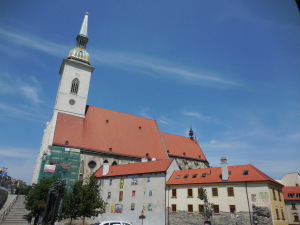 St. Martin’s Cathedral
St. Martin’s CathedralThen the powerful Habsburg monarch took control of the region and it became an important place with 11 royals being crowned in the historic St Martin’s cathedral. The Habsburgs ruled the country for 200 long years, building grand palaces and structures. Not too many of them have survived the onslaught of time, yet the tiny area of Old Town is replete with centuries-old buildings. Given the constant restorations, Bratislava can rightly boast of its marvellously conserved medieval buildings that bring tourists by the drove. The remnants of the communist era are interspersed with those of Maria Theresa’s opulent ones.
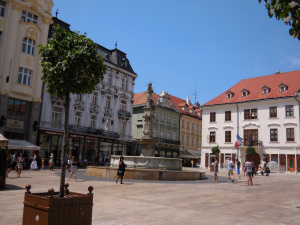 Old Town square
Old Town squareThe Slovakian capital may be small in size but the quaint old town promises many interesting sights along its constricted, winding cobbled streets. It was in Vienna that I came across a brochure about Bratislava and took an impromptu decision to join the hundreds of day-trippers to that city.
The Old Town, with its pedestrian-only rule, is an easy place to navigate. That is, if you don’t mind the truly narrow, cobbled streets. The Renaissance and Baroque mix Town Hall, Neo Renaissance Primatial Palace, St Michael’s Gate and most other structures are located within a radius of a couple of kilometres.
The Hlavné nám or Main Square is where the action lies. With the Roland’s Fountain, Napolean’s soldier and a plethora of cafes lining its sides, this is the favourite place of weary tourists sneaking in a tankard of beer before trudging through the streets once again. This is also where the walking tours begin.
At one end of the Main Square stands the neo-Gothic Old Town Hall, which houses the City Museum. The 15th century hall was reconstructed in the Renaissance style after being damaged by an earthquake.
Primate’s Palace
Nearby, the Primate’s Palace of 1778 is considered to be one of the most striking buildings in the city. The building is crested by a big cast iron cardinal’s hat, which stands as a testimony to the various cardinals who lived here. It was in the Hall of Mirrors of this palace that the historical Treaty of Pressburg was signed between Austrian emperor Franz I and Napolean.
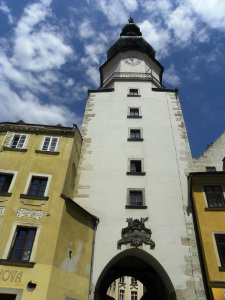 Michael’s Gate
Michael’s GateA short walk through the streets leads to the St Michael’s Gate, the only one remaining of the four gates to the Old Town. Topped with a statue of St Michael, the tower forms a part of the old fortification. A viewing platform on the top promises a panoramic view of the town, drawing visitors eager for a good photo-op.
A Prešporáčik (a tiny red train) hoots patiently as I amble towards the Gothic St Martin’s Cathedral at the end of the street. Built in the 13th century, this was where many kings and a queen—Maria Theresa—of the Habsburg monarchy were crowned. The cathedral has several chapels, which were added over the centuries. Interestingly, a replica of the Hungarian royal crown is positioned on the church tower. Although the exterior is not very impressive, the three-aisle interior has striking art work and exquisite stained-glass windows.
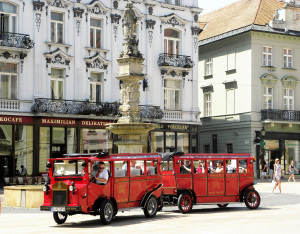 The little red bus that takes tourists around Old Town
The little red bus that takes tourists around Old TownThe modest Bratislava Castle, staring imperiously at the city from atop its hilly perch, was next on my agenda. The chosen site for fortresses since ancient times, it had once been a Roman outpost. The present castle has been reconstructed several times since it was first built. Featured on Slovak coins, the castle offers splendid views of the city.
Then there is the St Elizabeth’s Church or the Little Blue Church as it is fondly known. Built in the Art Nouveau style, it is adorned with beautiful blue Majolica tiles.
There are umpteen museums, art galleries and opera theatres for those interested in catching up with culture but then you need to do a little more than day-tripping to enjoy those.
Bratislava is definitely an underrated city on all counts, one that definitely needs to be included in the itinerary of those who are making a trip to eastern Europe.
Reaching there
Although Bratislava has its own airport, few tourists fly to the city. Most use a bus or a train, which takes just about an hour from Vienna. The ‘Bratislava Ticket’ offered by OBB costs 15 euros round-trip per person (adult) and includes free use of buses and tram at Bratislava. There are boats from Vienna that take tourists along the much-romanticised Danube.
Getting around
The old town is a pedestrian-only zone but those who do not wish to walk can take the quaint tourist train.
Accommodation
For those planning more than a day-trip, Bratislava has a range of hotels from the top end to the budget. Marrol’s Boutique Hotel and Double Tree Hilton are at the expensive end. There are many low-cost hotels as well as hostels.
Food
Slovakian cuisine is an amalgamation of the Hungarian, Austrian and local cuisine. The local favourite, bryndzové halusky (Slovak version of dumplings), is a concoction of potato-noodles with egg and sharp cheese along with bits of bacon. Bratislavsk ro‑ok (walnut or poppy seed-filled croissant) and local beer are very popular. Also popular are Kapustnica (soup made of sour cabbage and smoked pork sausage) and Slovak Goulash. Brave travellers can sample the Slivovice, a plum brandy with an alcohol content of 50 per cent that dates back to the 16th century.
Shopping
After Vienna, Bratislava comes as a pleasant surprise for the budget travellers. The city is really inexpensive. Amber, lace and ceramic objects are worth buying.
Best time to visit
May and June are the best times to visit the city because of the mild weather. Those planning to go to Bratislava during the winter must visit the Christmas market when the locals gather at the city centre to enjoy loke (potato pancakes) and drink mulled wine.
(Published in The Week on 25 October, 2015)
Filed under: Travel, Wine and Cuisine Tagged: Bratislava, Cumil, Czechoslovakia, Hapsburgs, Maria Theresa, Napolean's soldier, Old Town, Prague, Primate's Palace, Ruberneck, Schöne Náci, Slovakia, St Michael's Gate, St. Martin's Cathedral, The Little Red Bus, Vienna 








